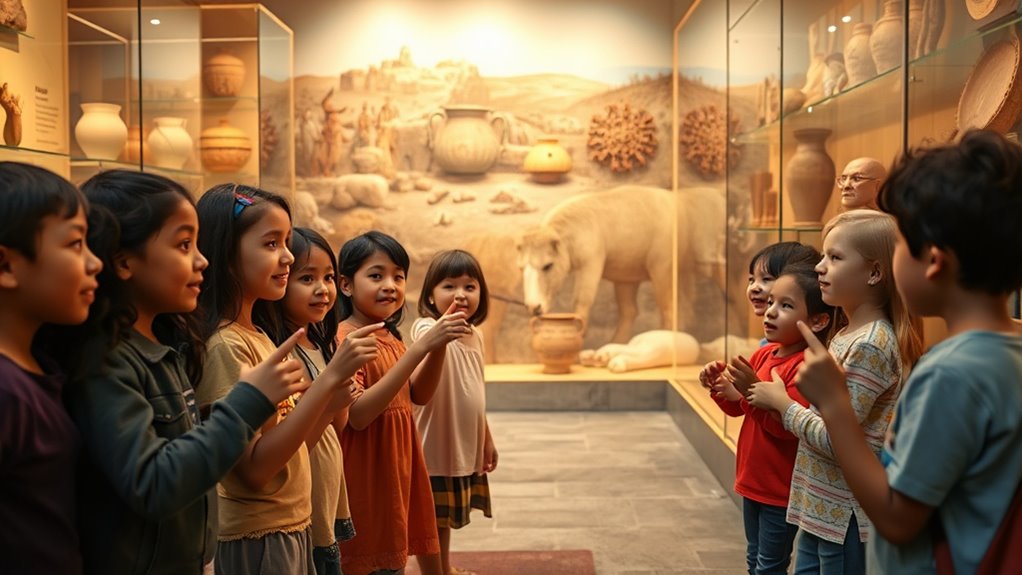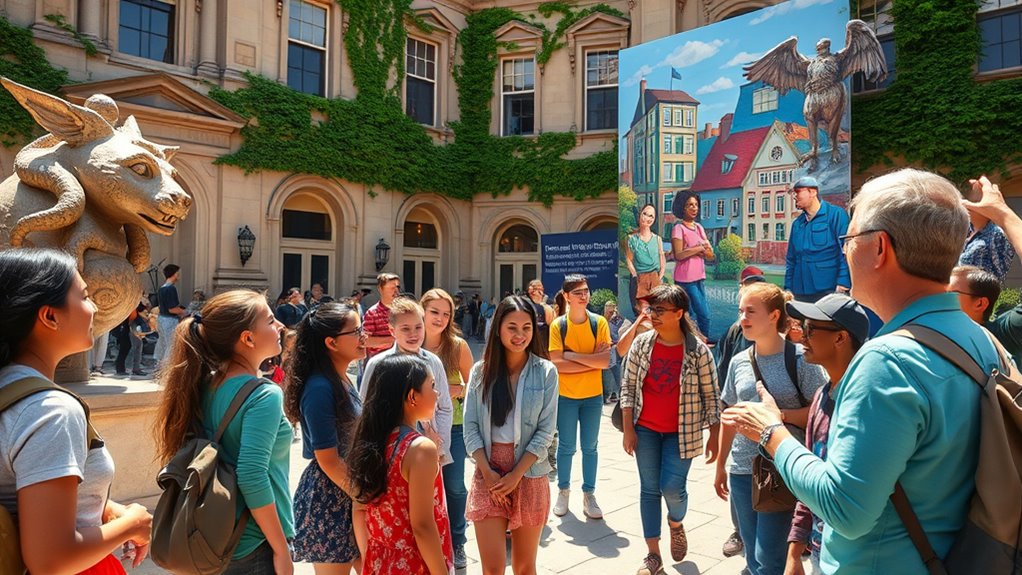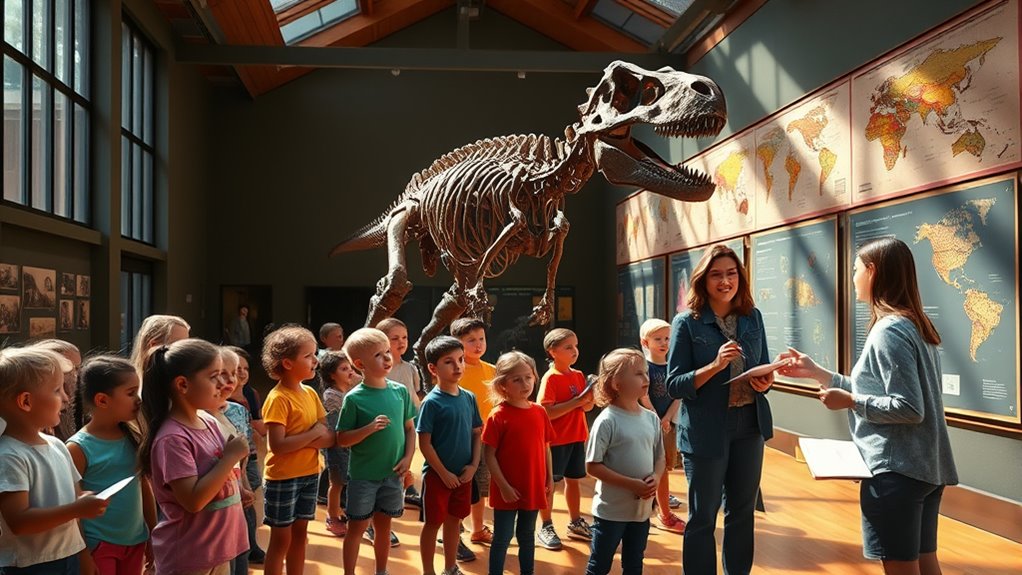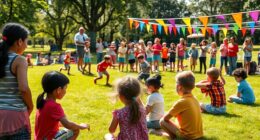Museums and historical sites are fantastic educational outings that deepen your understanding of history. By engaging with exhibits, you connect emotionally to diverse narratives and perspectives. Interactive experiences enhance your retention and motivation, making learning enjoyable. These sites promote community engagement, offering diverse voices and collaborative opportunities. When you prepare for your visit, you’ll bridge theoretical knowledge with real-world insights. Discover how these enriching experiences can transform your learning journey as you explore further.
Key Takeaways
- Museums and historical sites provide tangible connections to history, enhancing students’ understanding of past events and cultural contexts.
- Interactive exhibits and immersive technologies engage learners actively, promoting better retention and comprehension of historical information.
- Collaborations with local organizations foster community involvement, ensuring diverse voices are represented in educational programming.
- Integrating museum experiences into classroom learning bridges theoretical knowledge with real-world applications, enriching student education.
- Post-visit reflections and digital resources extend learning opportunities, helping students connect museum experiences back to their studies.
Enhancing Historical Literacy Through Museum Visits

When you visit a museum, you connect with history in a tangible way that deepens your understanding of past events. Engaging with exhibits enhances your grasp of historical timelines and the cultural contexts surrounding artifacts. You’ll encounter diverse narratives that enrich your perspective, fostering critical thinking as you analyze primary sources. These artifacts encourage you to question their significance and origins, promoting a deeper retention of historical knowledge. Interactive displays cater to your learning style, while expert insights during guided tours provide authoritative context. By exploring these connections, you not only improve your recall of facts but also spark curiosity, inspiring independent research and exploration of history. Additionally, museums encourage analysis of historical narratives from multiple perspectives, allowing for a more nuanced understanding of events. Ultimately, museums cultivate a lasting appreciation for the complexities of our past, particularly in the context of global political climate that shapes historical interpretations and cultural memory. The incorporation of natural elements in museum design can create a more inviting atmosphere that enhances the overall educational experience. Moreover, engaging with sound healing techniques within museum settings can further enrich visitors’ emotional connections to the exhibits. Visiting farm museums can provide an immersive experience that highlights rural life and agricultural history, deepening your appreciation for the cultural heritage of farming communities. Museums like those in Kalamazoo’s cultural institutions also offer valuable insights into local history and community engagement.
Immersive Learning Experiences at Historical Sites

As you step into a historical site enhanced by immersive technologies, you’re not just observing history; you’re experiencing it firsthand. Virtual and augmented reality transport you to pivotal moments, making narratives come alive.
At places like Titanic Belfast or the D-Day Museum, interactive galleries let you engage with history actively, enhancing your understanding and retention. These experiences promote critical thinking and foster emotional connections, allowing you to appreciate cultural heritage deeply. Virtual activities broaden access to historical learning experiences, ensuring that more individuals can participate in these enriching opportunities. Engaging with these immersive experiences also helps develop cultural intelligence by fostering deeper connections to diverse narratives and perspectives. The use of high-quality equipment in these settings ensures that sound and visuals contribute to a more realistic experience, much like how energy-efficient models optimize resources in a heat pump system. Moreover, utilizing high refresh rates in projectors can enhance the clarity of visual displays, making learning experiences even more engaging. Additionally, cities like Washington D.C. offer numerous museums that provide free admission on select days, enhancing accessibility for all.
Role-playing activities and art-inspired sessions enable you to embody historical figures, gaining insight into their perspectives. By integrating physical and virtual interactions, these sites cater to diverse learning styles, making history feel relevant and exciting, and sparking a lifelong interest in the past.
Fostering Historical Empathy and Understanding

Experiencing history through immersive technologies lays a strong foundation for fostering historical empathy and understanding.
Culturally-centered museums highlight specific historical moments and artifacts, helping you connect emotionally with the past. By engaging with primary sources and personal testimonies, you can better appreciate different perspectives. In fact, culturally-centered museums can effectively foster empathy by creating emotional connections to historical narratives. Research shows that children’s emotional expression can be enhanced through these experiences, allowing them to process complex historical events more deeply. This is crucial because studies indicate that emotional disconnection can hinder the ability to relate to others’ experiences. The importance of emotional and psychological growth during childhood stages underscores the need for such educational interactions. Additionally, many retreats designed for spiritual growth offer insights into personal reflection and emotional healing, further enhancing empathy. Furthermore, these experiences can also help cultivate unconditional love, which is essential in understanding diverse human experiences.
Museums like the Empathy Museum utilize interactive exhibits, encouraging you to reflect on various life experiences. Educational programs emphasize empathetic understanding, making history more relatable.
Exhibitions that require you to walk in someone else’s shoes deepen your emotional connection to historical narratives. As you explore diverse perspectives, you gain insight into complex events and their ongoing impacts, transforming your understanding of history and promoting social justice awareness.
Promoting Community Engagement Through Museums

Museums play an essential role in promoting community engagement, especially when they actively collaborate with local organizations. By forming partnerships, you can amplify outreach and include diverse voices in decision-making, tailoring programs to better serve your community’s needs. Special events, such as themed breakfasts, can be a unique way to attract varied audiences and foster social interaction within the community. Moreover, these events can lead to unbeatable savings for families seeking affordable educational experiences. Additionally, hosting interactive exhibits can enhance visitor participation and broaden educational opportunities.
Incorporating omega-3 fatty acids into community wellness programs can also improve cognitive function and enhance learning experiences. Interactive exhibits and personalized tours cater to various interests, encouraging hands-on engagement and repeat visits. Utilizing multiple marketing channels, like social media and newsletters, helps you reach different community segments effectively. Audience engagement is crucial in assessing community perception and improving existing programs. Furthermore, incorporating psychological principles from relationship dynamics can deepen connections between visitors and the museum experience.
Establishing community advisory boards guarantees your programming remains relevant and inclusive. When you value local experiences as much as museum expertise, you foster collaborative learning. Ultimately, successful community engagement transforms museums into vibrant, community-driven spaces that reflect and celebrate the diversity of their audiences.
Integrating Museum Experiences Into Educational Curricula

Integrating museum experiences into educational curricula enriches student learning by bridging the gap between theoretical knowledge and real-world applications.
By aligning museum resources with your classroom subjects, you create dynamic learning opportunities in history, science, and art. Preparing your students before visits helps set context, encouraging engagement through critical questions. Creative practice can also be incorporated into the curriculum to enhance students’ problem-solving skills and innovative thinking. Engaging with astrological compatibility may also encourage students to explore personal interests and strengths during group activities. Additionally, many museums offer extended hours during peak seasons to accommodate school groups. For instance, vibrant city life in places like Atlanta can provide a rich backdrop for learning about cultural history. Moreover, integrating holistic living practices into museum visits can encourage a deeper appreciation for heritage and personal well-being.
Once at the museum, interactive exhibits foster active learning, especially in STEM fields, enhancing student interest and motivation. Post-visit reflections deepen understanding, allowing students to connect their experiences back to the classroom.
With many museums offering digital resources and virtual tours, you can enhance learning without geographical limits. Collaborating with museums for workshops or programs can also boost motivation, critical thinking, and twenty-first-century skills, making learning more relevant and impactful.
Frequently Asked Questions
What Types of Artifacts Can I Expect to See in Museums?
When you visit museums, you can expect to see a variety of artifacts. You might find pottery used for storage, ancient jewelry crafted from precious materials, and tools or weapons that tell stories of past civilizations.
Don’t miss the impressive armor or decorative figurines. Museums also showcase artworks, historical documents like manuscripts or maps, and even early scientific instruments that highlight technological advancements.
Each artifact offers a glimpse into history, igniting your curiosity.
Are There Age-Specific Programs for Children at Museums?
Yes, there are age-specific programs for children at many museums. You’ll find offerings tailored for various age groups, from toddlers to teens, designed to engage and educate.
These programs often include hands-on activities, interactive exhibits, and storytelling. For younger kids, you might encounter programs that focus on exploration and creativity, while older children can participate in art and science initiatives that encourage critical thinking.
It’s a great way to spark their curiosity!
How Can I Get Involved With My Local Museum?
Imagine stepping into a world where history comes alive, and you’re the guide.
To get involved with your local museum, check their website for volunteer opportunities. You’ll find roles like tour guide or event staff, where you’ll learn and share stories with visitors.
Attend training sessions to sharpen your skills, and connect with others passionate about history.
Get ready to create memorable experiences that enrich your community and ignite curiosity!
What Is the Best Time to Visit a Museum for Fewer Crowds?
To visit a museum with fewer crowds, try going on weekdays, especially Tuesday through Thursday.
Arriving right when it opens or in the late afternoon can also help you avoid the busiest times.
Additionally, steer clear of peak tourist seasons like summer or major holidays.
Check the museum’s website for special events or exhibitions that might attract larger crowds, and consider visiting during off-peak times for a more peaceful experience.
Do Museums Offer Any Virtual Tours or Online Resources?
Did you know that over 3,000 museums worldwide now offer virtual tours?
You’ll find plenty of options, like the Vatican Museums and Google Arts & Culture, which allow you to explore art and history from your home.
The National Museum of Natural History also provides self-guided tours of its exhibits.
These online resources make it easy for you to access educational content and engage with cultural heritage, regardless of location or financial constraints.
Conclusion
So, next time you’re dragging your feet to a museum, remember: who needs Netflix when you can stare at dusty artifacts and read plaques, right? But seriously, these outings aren’t just about avoiding chores; they’re goldmines for enriching your understanding of history. By immersing yourself in the past, you might just find that engaging with your community and cultivating empathy isn’t as boring as it sounds. After all, history isn’t just for old folks—it’s for everyone willing to learn!









